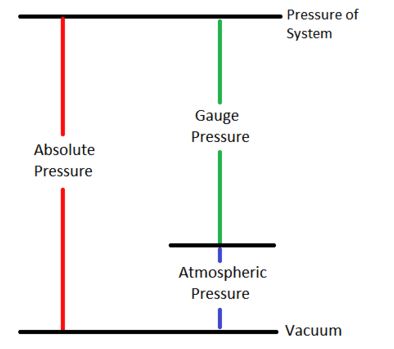Everyday pressure measurements such as for vehicle tire pressure are usually made relative to ambient air pressure. In other cases, measurements are made relative to a vacuum or to some other specific reference. When distinguishing between these zero references, the following terms are typically used:
- Absolute pressure:
- Gauge Pressure
- Differential pressure

Gauge Pressure
Gauge pressure is the relative pressure of the compressed air within a system. Gauge pressure can either be positive or negative, depending upon whether its level is above or below the atmospheric pressure or barometric pressure reference. Usually, atmospheric pressure serves as the reference level for the most significant types of pressure measurements.
Gauge pressure is zero-referenced against ambient air pressure; therefore, it is equal to absolute pressure minus atmospheric pressure. A pressure gauge is often used to measure the pressure difference between a system and the surrounding atmosphere. Formula for gauge pressure is given by:
Gauge Pressure=Absolute Pressure – Atmospheric Pressure (Prel=Pabs-Patm).
What You Need To Know About Gauge Pressure
- Gauge pressure can be described as the pressure measured against the zero atmospheric pressure.
- Gauge pressure is sometimes referred to as ‘overpressure’.
- Gauge pressure is cited against the ambient air pressure.
- Change in atmospheric pressure affects gauge pressure.
- Formula for gauge pressure is given by Gauge Pressure=Absolute Pressure – Atmospheric Pressure. (Prel=Pabs-Patm).
- Gauge pressure is used mainly for conventional purposes.
- Gauge pressure is uses atmospheric pressure as it’s zero point (reference point).
- Due to varying atmospheric pressure, gauge pressure measurement is not precise; the value is usually the relative value of the measured pressure.
- Gauge pressure can be positive or negative.
- Gauge pressure is measured by use of a pressure gauge.
- Unit for measurement of gauge pressure are kPag, psig and barg. Where ‘g’ is the suffix given.
- Gauge pressure is commonly used in measurement of blood pressure or air pressure in vehicle tires.
Absolute Pressure
Absolute pressure is zero-referenced against a perfect vacuum, using an absolute scale; therefore it is equal to gauge pressure plus atmospheric pressure. A barometer or manometer is often used to measure the pressure difference between a system relative to a vacuum. Absolute Pressure can be expressed by the following formula:
Absolute Pressure=Gauge Pressure +Atmospheric Pressure (Pabs=Prel +Patm).
What You need to know About Absolute Pressure
- Absolute pressure can be described as the pressure measured against the zero pressure of a vacuum.
- Absolute pressure is sometimes referred to as ‘total systems pressure’.
- Absolute pressure is cited against perfect vacuum.
- Change in atmospheric pressure doesn’t affect absolute pressure.
- Formula for absolute pressure is given by Absolute Pressure=Gauge Pressure +Atmospheric Pressure. (Pabs=Prel +Patm).
- Absolute pressure is mainly used to measure pressures for aircrafts etc.
- Absolute pressure is measured from zero (absolute pressure uses absolute zero as its zero point/ reference point).
- Absolute pressure is always definite; the absolute pressure value is the absolute value of the measured pressure.
- Absolute pressure is always positive and cannot be negative.
- Absolute pressure is measured by use of manometer or barometer.
- Units for measurement of absolute pressure are psia and kpaa. Where ‘a’ is the suffix given.
- Absolute pressure is used for scientific experimentations and calculations. Examples are altimeter, air pressure, measurement of deep vacuum pressures by scientists etc.
Difference Between Absolute Pressure And Gauge Pressure
| BASIS OF COMPARISON | GAUGE PRESSURE | ABSOLUTE PRESSURE |
| Description | Gauge pressure can be described as the pressure measured against the zero atmospheric pressure. | Absolute pressure can be described as the pressure measured against the zero pressure of a vacuum. |
| Alternative Name | It is sometimes referred to as ‘overpressure’. | It is sometimes referred to as ‘total systems pressure’. |
| Citation | It is cited against the ambient air pressure. | It is cited against perfect vacuum. |
| Change In Atmospheric Pressure | Change in atmospheric pressure affects gauge pressure. | Change in atmospheric pressure doesn’t affect absolute pressure. |
| Formula | Gauge Pressure=Absolute Pressure – Atmospheric Pressure. (Prel=Pabs-Patm). | Absolute Pressure=Gauge Pressure +Atmospheric Pressure. (Pabs=Prel +Patm). |
| Use | It is used mainly for conventional purposes. | It is mainly used to measure pressures for aircrafts etc. |
| Zero Point | It is uses atmospheric pressure as it’s zero point (reference point). | It uses absolute zero as its zero point/ reference point. |
| Accuracy | Due to varying atmospheric pressure, gauge pressure measurement is not precise. | Absolute pressure is always definite. |
| Values | Value can be positive or negative. | Value is always positive and cannot be negative. |
| Measurement Instrument | It is measured by use of a pressure gauge. | It is measured by use of manometer or barometer. |
| Units For Measurement | Units for measurement of gauge pressure are kPag, psig and barg. Where ‘g’ is the suffix given. | Units for measurement of absolute pressure are psia and kpaa. Where ‘a’ is the suffix given. |
| Use | It is commonly used in measurement of blood pressure or air pressure in vehicle tires. | It is used for scientific experimentations and calculations. |